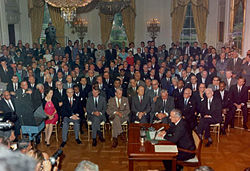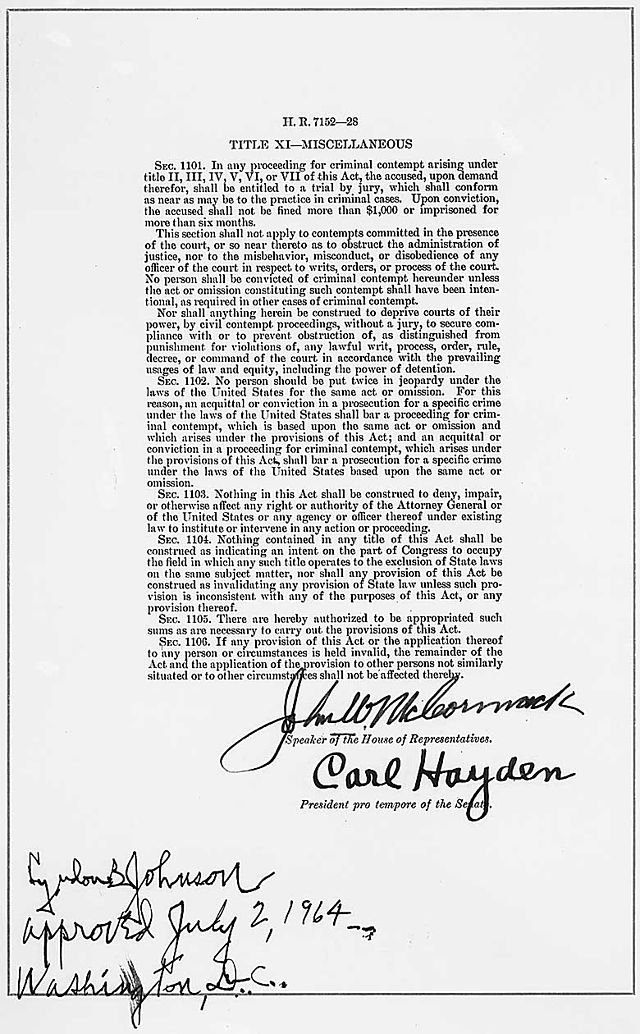Civil Rights Act Of 1964
 From Conservapedia
From Conservapedia 
The Civil Rights Act of 1964 was a landmark in legislative attempts to improve the quality of life for African Americans and other minority groups. Although civil rights had a long history as a political and legislative issue, the 1960s marked a period of intense activity by the federal government to protect minority rights. The Act did not resolve all problems of discrimination. But it opened the door to further progress by lessening racial restrictions on the use of public facilities, providing more job opportunities, strengthening voting laws, and limiting federal funding of discriminatory aid programs. The Civil Rights Act of 1964 was passed by Congress based on the Commerce Clause, not the 14th Amendment, in order to apply to private (non-state) actors such as small restaurants.
The story of the 1964 Civil Rights Act is interesting and instructive because it illustrates how an historically important piece of legislation became part of our nation's heritage. Democrats attempted to block the passage of the Act by filibustering for 75 hours, including a 14-hour and 13 minute address by Senator Robert Byrd.[1] An examination of the Act also provides a way to understand the climate of opinion regarding African American rights, the nature of civil rights activity, the obstacles to political and social change, the role of politics in the way issues are handled, the actions of individual senators and representatives, and the nature of legislative activity in general. The intricate process that makes a bill become law is a combination of all these factors.
The "Civil Rights Act of 1964" pushed to make the Declaration of Independence's inalienable rights of "life, liberty, and the pursuit of happiness" a reality for all Americans.
The Civil Rights Act of 1964, which banned discrimination in public accommodations, employment and federally funded activities like education, would not have passed without the support of House and Senate Republicans who were competing for black votes. And Presidents Kennedy and Johnson would not have advocated for the bill without being pressured to do so by a multiracial grass-roots movement. [1]

| “ |
This nation was founded on the principle that all men are created equal, and that the rights of every man are diminished when the rights of one man are threatened. ... It ought to be possible, in short, for every American to enjoy the privileges of being American without regard to his race or his color. In short, every American ought to have the right to be treated as he would wish to be treated, as one would wish his children to be treated. But this is not the case. ... We are confronted primarily with a moral issue. It is as old as the scriptures and is as clear as the American Constitution. ... One hundred years of delay have passed since President Lincoln freed the slaves, yet their heirs, their grandsons, are not fully free. ... And this nation, for all its boasts, will not be fully free until all its citizens are free. — President Kennedy. |
” |
Contents
- 1 Civil Rights Act voting results by party
- 2 Civil Rights Act and the Equal Employment Opportunity Commission
- 3 See also
- 4 External links
- 5 References
Civil Rights Act voting results by party[edit]
The original House version:
Democratic Party: 152–96 (61–39%)
Republican Party: 138–34 (80–20%)
Cloture in the Senate:
Democratic Party: 44–23 (66–34%)
Republican Party: 27–6 (82–18%)
The Senate version:
Democratic Party: 46–21 (69–31%)
Republican Party: 27–6 (82–18%)
The Senate version, voted on by the House:
Democratic Party: 153–91 (63–37%)
Republican Party: 136–35 (80–20%)
Civil Rights Act and the Equal Employment Opportunity Commission[edit]
In the 1960s, Americans who knew only the potential of "equal protection of the laws" expected the President, the Congress, and the courts to fulfill the promise of the 14th Amendment. In response, all three branches of the federal government—as well as the public at large—debated a fundamental constitutional question: Does the Constitution's prohibition of denying equal protection always ban the use of racial, ethnic, or gender criteria in an attempt to bring social justice and social benefits?

In 1964 Congress passed Public Law 82-352 (78 Stat. 241). The provisions of this civil rights act forbade discrimination on the basis of sex as well as race in hiring, promoting, and firing. The word "sex" was added at the last moment. According to the West Encyclopedia of American Law, Representative Howard W. Smith (D-VA) added the word. His critics argued that Smith, a conservative Southern opponent of federal civil rights, did so to kill the entire bill. Smith, however, argued that he had amended the bill in keeping with his support of Alice Paul and the National Women's Party with whom he had been working. Martha W. Griffiths (D-MI) led the effort to keep the word "sex" in the bill. In the final legislation, Section 703 (a) made it unlawful for an employer to "fail or refuse to hire or to discharge any individual, or otherwise to discriminate against any individual with respect to his compensation, terms, conditions or privileges or employment, because of such individual's race, color, religion, sex, or national origin." The final bill also allowed sex to be a consideration when sex is a bona fide occupational qualification for the job. Title VII of the act created the Equal Employment Opportunity Commission (EEOC) to implement the law.
Subsequent legislation expanded the role of the EEOC. Today, according to the U. S. Government Manual of 1998-99, the EEOC enforces laws that prohibit discrimination based on race, color, religion, sex, national origin, disability, or age in hiring, promoting, firing, setting wages, testing, training, apprenticeship, and all other terms and conditions of employment. Race, color, sex, creed, and age are now protected classes. The proposal to add each group to protected-class status unleashed furious debate. But no words stimulate the passion of the debate more than "affirmative action."
As West defines the term, affirmative action "refers to both mandatory and voluntary programs intended to affirm the civil rights of designated classes of individuals by taking positive action to protect them" from discrimination. The issue for most Americans is fairness: Should the equal protection clause of the 14th Amendment be used to advance the liberty of one class of individuals for good reasons when that action may infringe on the liberty of another?
The EEOC, as an independent regulatory body, plays a major role in dealing with this issue. Since its creation in 1964, Congress has gradually extended EEOC powers to include investigatory authority, creating conciliation programs, filing lawsuits, and conducting voluntary assistance programs. While the Civil Rights Act of 1964 did not mention the words affirmative action, it did authorize the bureaucracy to makes rules to help end discrimination. The EEOC has done so.
Today the regulatory authority of the EEOC includes enforcing a range of federal statutes prohibiting employment discrimination. According to the EEOC's own Web site, these include Title VII of the Civil Rights Act of 1964 that prohibits employment discrimination on the basis of race, color, religion, sex, or national origin; the Age Discrimination in Employment Act of 1967, and its amendments, that prohibits employment discrimination against individuals 40 years of age or older; the Equal Pay Act of 1963 that prohibits discrimination on the basis of gender in compensation for substantially similar work under similar conditions; Title I of the Americans with Disabilities Act of 1990 that prohibits employment discrimination on the basis of disability in both the public and private sector, excluding the federal government; the Civil Rights Act of 1991 that provides for monetary damages in case of intentional discrimination; and Section 501 of the Rehabilitation Act of 1973, as amended, that prohibits employment discrimination against federal employees with disabilities. Title IX of the Education Act of 1972 forbade gender discrimination in education programs, including athletics that received federal dollars. In the late 1970s Congress passed the Pregnancy Discrimination Act. This made it illegal for employers to exclude pregnancy and childbirth from their sick leave and health benefits plans.
Presidents also weighed in, employing a series of executive orders. President Lyndon B. Johnson ordered all executive agencies to require federal contractors to "take affirmative action to ensure that applicants are employed and that employees are treated during employment without regard to race, color, religion, sex, or national origin." This marked the first use of the phrase "affirmative action." In 1969 an executive order required that every level of federal service offer equal opportunities for women and established a program to implement that action. President Richard Nixon's Department of Labor adopted a plan requiring federal contractors to assess their employees to identify gender and race and to set goals to end any under-representation of women and minorities. By the 1990s Democratic and Republican administrations had taken a variety of actions that resulted in 160 different affirmative action federal programs. State and local governments were following suit.
The courts also addressed affirmative action. In addition to dealing with race, color, creed, and age, from the 1970s forward, the court dealt with gender questions. It voided arbitrary weight and height requirements (Dothard v. Rawlinson), erased mandatory pregnancy leaves (Cleveland Board of Education v. LaFleur), allowed public employers to use carefully constructed affirmative action plans to remedy specific past discrimination that resulted in women and minorities being under-represented in the workplace (Johnson v. Transportation Agency, Santa Clara County), and upheld state and local laws prohibiting gender discrimination.
By the late 1970s all branches of the federal government and most state governments had taken at least some action to fulfill the promise of equal protection under the law. The EEOC served as the agent of implementation and complaint. Its activism divided liberals and conservatives, illuminating their differing views about the proper scope of government. In general, the political liberals embraced the creation of the EEOC as the birth of a federal regulatory authority that could promote the goal of equality by designing policies to help the historically disadvantaged, including women and minorities. In contrast, political conservatives saw the EEOC as a violation of their belief in fewer government regulations and fewer federal policies. To them, creating a strong economy, free from government intervention, would produce gains that would benefit the historically disadvantaged. Even the nonideological segment of the American population asked: What should government do, if anything, to ensure equal protection under the law?
In fiscal year 1997, the EEOC collected $111 million in financial benefits for people who filed claims of discrimination. Its recent successful efforts include a $34 million settlement in a sexual harassment case with Mitsubishi Motor Manufacturing of America, resulting in the company's adoption of changes to its sexual harassment prevention policy. Working with state and local programs, the EEOC processes 48,000 claims annually.[2]
See also[edit]
- EEOC
External links[edit]
- Civil Rights Bill Passes in the House.
- Civil Rights Address. Delivered 11 June 1963.
- 5 Things to Know About the 1964 Civil Rights Act.
References[edit]
- ↑ Civil Rights Filibuster Ended. Art & History Historical Minutes. United States Senate. Retrieved on March 1, 2010.
- ↑ The National Archives
Categories: [United States Law] [Civil Rights] [United States Government Agencies]
↧ Download as ZWI file | Last modified: 02/11/2023 12:16:41 | 24 views
☰ Source: https://www.conservapedia.com/Civil_Rights_Act_of_1964 | License: CC BY-SA 3.0
 ZWI signed:
ZWI signed: KSF
KSF